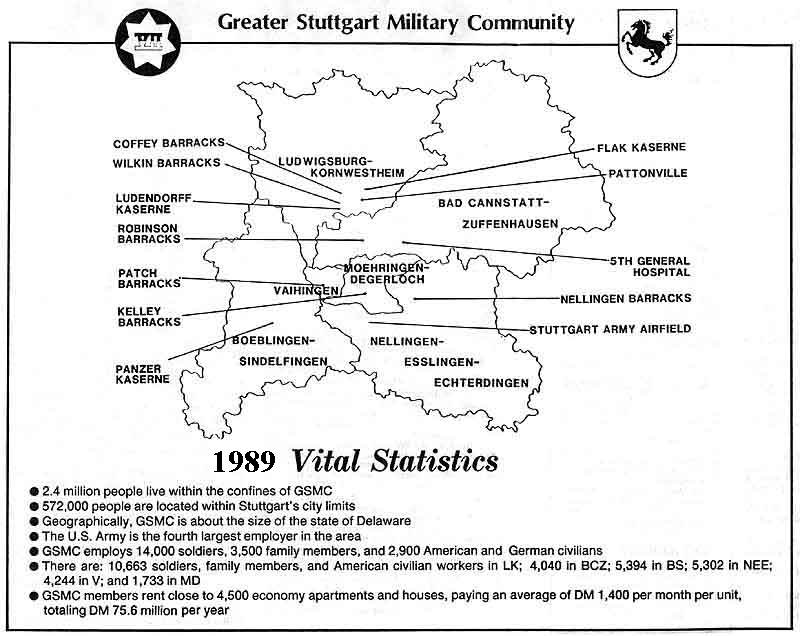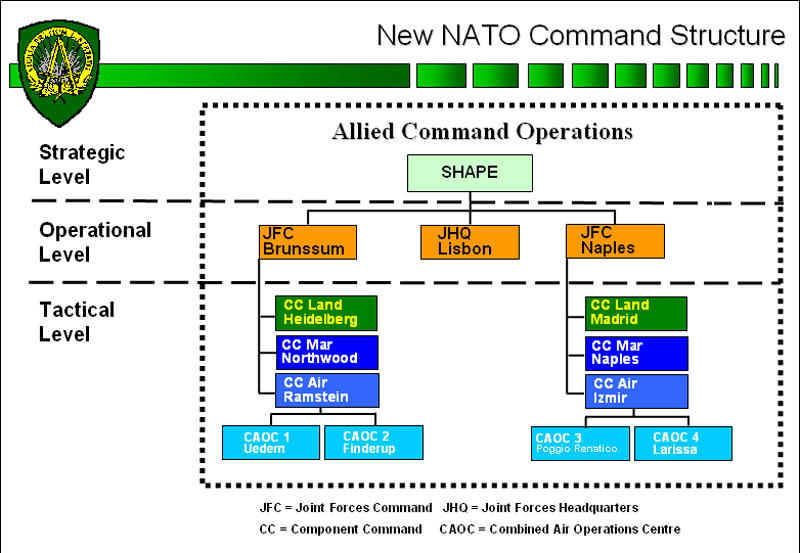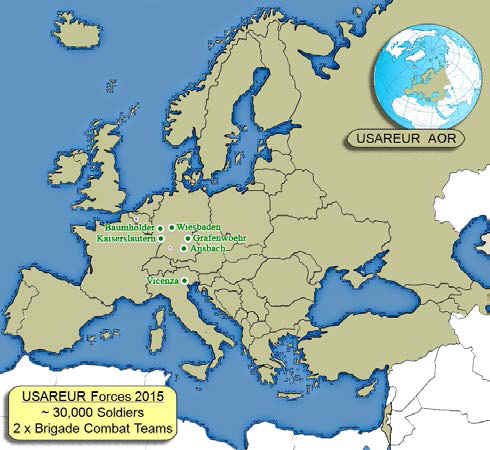The U.S. Army disbanded its Germany based VII Corps several years ago, yet it plans to retain some of its remaining USAG Stuttgart base network open. There is no seaport in this region for rapid deployment and no major American airbase nearby. There are no large training areas or potential enemies in the region. It's a nice, peaceful and expensive area to maintain overseas bases. So why retain these unneeded bases?

Most of the U.S. Army bases around Stuttgart (pictured) closed after the Cold War ended in 1990, only five remain:
1. Kelley Barracks should have closed years ago, but remains open as a temporary home for the new U.S. Africa Command. A permanent home in Africa, Italy, or the USA should be announced soon, or it may be disbanded.
2. Patch Barracks could close if its U.S. European Command headquarters wisely moved to a huge, newly constructed command building at USAG Wiesbaden, where its largest component is based -- U.S. Army Europe. Civilian leaders recently forced the Army to disband its unneeded 750-man V Corps command element. The Army had just completed new office space for V Corps at Wiesbaden, so there is room for the rest of the European Command now at Patch.
3. Stuttgart Army Airfield is a small U.S. Air
Force installation adjacent to the
German Stuttgart airport where aircraft visit to transport Army Generals. These
missions could shift to Wiesbaden Army Airfield if the European Command moves
there,
and would end once Africa Command moves or disappears.
4. Robinson Barracks is a family housing area, which should disappear as the other bases close. Unfortunately, the Army recently paid German companies and their workers over $100 million to upgrade most housing units (right).
5. Panzer Kaserne hosts a hundred Marines as a "component" command of the European Command. It could move to Wiesbaden, or if their Marine General wants to better command the few U.S. Marines scattered around the Mediterranean, his headquarters personnel could move to a U.S. Navy base in the Mediterranean. The Marines could shed a "second land army" appearance and rejoin the U.S. Naval Forces Europe/Africa Command in Italy, from which they spun off a few years ago when Secretary Rumsfeld ousted the Navy from its big headquarters in London. Marines may occasionally embark on the Navy's 6th Fleet command ship at Naples. The Navy recently downsized its big headquarters up the hill at Gaeta, so there is plenty of vacant space.
Is the European Command Needed?
American forces in NATO nations fall under the Supreme Headquarters Allied Powers Europe (SHAPE). It is always commanded by a four-star American General with hundreds of American servicemen serving in and around our two U.S. Army bases in Belgium. The commander of SHAPE also commands the U.S. European Command, several hours away in Germany. No one thinks the USA will (or can) conduct military operations in Europe outside the NATO command structure, so why does the European Command exist?
Just 20 years ago, the European Command ruled over 500,000 GIs in Europe and focused on repelling a Soviet invasion of Europe. The Warsaw Pact is long gone and European Command now commands fewer than 70,000 GIs, mostly headquarters and base personnel, so the huge European Command mostly performs administrative housekeeping.

NATO has its own integrated command structure (above), and several thousand Americans are part of this NATO command structure. The huge European Command really doesn't command anything. No one thinks the USA would (or could) conduct independent military operations in Europe outside the NATO command structure. Our NATO allies are proud, modern nations and would not permit the American military to use bases on its territory or its airspace for military operations unless NATO approves.
The idea of eliminating the redundant European Command to save money and reinforce our commitment to NATO will shock and anger the dozens of American Generals in Germany, and their thousands of support personnel. USAG Wiesbaden has a military community population of 18,500, including: 3,400 troops, 3,300 civilian employees, 1,100 German employees, 9,600 family members and 1,100 retirees, just to host the U.S. Army "component" layer of command, whose basic mission is to pass along messages.
Our
civilian leadership must demand that our European Command consolidate at Wiesbaden, where the Army just spent a half billion
dollars for new command facilities. This includes $125 million for the 285,000-square-foot
Mission
Command Center for U.S. Army Europe (the biggest "component" of
the U.S. European Command). The 750-man V Corps command element was destine for
this center, but was wisely deactivated this year after strong civilian leaders
deemed it redundant. Therefore, the 1000 servicemen assigned
to the European Command at USAG Stuttgart can move here and save manpower by
merging with its Army component.
Nothing Special in Stuttgart
The only operational elements in the Stuttgart area are a few sailors with a U.S. Navy special operations unit, which could move to Wiesbaden, or Mildenhall where their aircraft are based, or to a Navy base in the Mediterranean. The 1st battalion of the Army's 10th Special Forces group with 500 soldiers at Panzer Kaserne would need a new home to train NATO soldiers. It could move to one of the Army's training bases in Bavaria (Grafenwoehr, Hohenfels or Ansbach), where NATO soldiers train. The 3000-man armored brigade at Graf will disband in 2013, so there will be plenty of room there.
A better option is to join its other three 10th Special Forces Group battalions at Fort Carson, Colorado. Small Special Forces teams could deploy from Fort Carson to different European military bases for a few months to live and train among foreign soldiers and citizens, which is their real role. This is far cheaper and provides better training than shuffling military families to expensive Stuttgart every three years while Dads deploy elsewhere.
Stealthy Army Bases
Since the end of World War II, a close relationship developed between wealthy German businessmen, local German mayors, German union leaders, Army civilian employees, and Army Generals. They join forces to demand whatever money they can secure from the Pentagon, regardless of national security needs. Army Generals never volunteer to close "their" bases and spend millions of dollars to improve them even if they are to be closed. The Army wasted $140 million on new construction at Kelley Barracks, which is supposed to close. This year, it will spend $5 million to upgrade 17 mansions for Generals in the Stuttgart area, even though the Africa Command with its dozen Generals will soon move from its "temporary" start up home.
 As
the U.S. Army's 1st Armored Division moved from Wiesbaden to Fort Bliss in
Texas, USAG Wiesbaden was sure to close. Army Generals declared they
would spend a half
billion dollars for new "command" facilities at Wiesbaden. However,
Generals will not
move the entire European Command there, only the Army "component" from
Heidelberg, which is a massively oversized administrative unit.
As
the U.S. Army's 1st Armored Division moved from Wiesbaden to Fort Bliss in
Texas, USAG Wiesbaden was sure to close. Army Generals declared they
would spend a half
billion dollars for new "command" facilities at Wiesbaden. However,
Generals will not
move the entire European Command there, only the Army "component" from
Heidelberg, which is a massively oversized administrative unit.
According to the U.S. Army Europe master plan, the Army will downsize to just six communities by 2015. USAG Stuttgart will disappear, at least from their map (pictured). Reading details we find that it will still exist, but now deemed a NATO/Joint/SOF military community, which the Army kindly supports. Several other U.S. Army communities disappear from this official map, simply by deleting their "garrison" title, such as the Army's resort at Garmisch. This is no oversight, but part of a two decade effort to preserve as many bases in Germany as possible by deception and delay.
The Stuttgart military community may seem busy to visitors, but nearly all manpower and money is devoted to running five sub-bases that have no military utility. This includes: 1706 family housing units, four post offices, four fitness centers, four clubs, four schools, three hotels, three chapels, three commissaries, two libraries, two banks, two arts and craft centers, a shopping mall, a bowling alley, a golf course, a theater, a swimming pool, a child development center, a medical center, a dental office, a veterinary office, and an auto hobby shop. All this to support just a thousand GIs at the dubious European Command headquarters and a few hundred combat soldiers who are better off elsewhere. The money and manpower wasted at USAG Stuttgart could be used to retain another combat brigade stateside! Our civilian leaders must quickly dictate the future location of Africa Command, order the European Command to merge with its Army component at Wiesbaden, and force the prompt closure of USAG Stuttgart.
Carlton Meyer editorG2mil@Gmail.com
©2012 www.G2mil.com
November 2013 Update
Generals say our Army is downsizing, too broke to train, and not ready for war. But that's no reason not to spend $100 million to start construction of a new elementary and new high school in Stuttgart, Germany. These are for school kids of our European Command soldiers, who have
no purpose since the NATO command in Belgium is really in charge, and led by the same American four-star General.